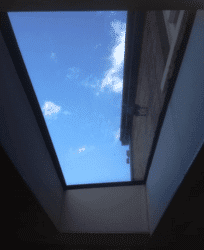Home improvement projects have changed over the years. Where a traditional bolt-on extension was once the default option builders are now able to offer homeowners a variety of options to make better use of their available space. Today’s home extensions can incorporate sliding or bifolding doors and contemporary windows. One key feature will be a lantern roof or a skylight.
If you are presently considering a glazed extension incorporating skylights we can offer some advice and guidance.
What is a Rooflight?

These are glazed panels designed to fit into a roof. Other terms for Rooflights are Skylights. Roof Windows or incorrectly referred to as Velux (although this is a separate brand and product in its own right.
Roof lights are designed to be fitted to either a flat or sloping roof, although depending upon the product some rooflights can be restricted by the degree of pitch.
What are the advantages of rooflights?
Rooflights have enjoyed a lot of popularity in the last five years as the home extension, renovation and “common theme” of these projects gains popularity. It is rare nowadays for a glazed extension not to incoporate some form of glazed element in the roof that brings extra light. And extra light from the roof brings many other advantages.
- A rooflight will provide valuable natural light and can reduce the amount of light fittings or artificial light planned.
- They are ultra contemporary and provide a real wow factor when included as part of a project.
- They can save money on heating bills as modern rooflights have excellent U Values.
- They come in many different forms including fixed, manual opening, automatic opening and even rooflights that can be walked on.
- Rooflights are available in double or triple glazing.
Are there any disadvantages to rooflights?

In theory no. Rooflights offer many advantages. Cost can be an issue as these will be generally more expensive than the traditional materials per square metre used to construct a roof. Prices will depend upon the product and the specification. Typical prices for an 900x900mm rooflight can range from £700 up to over £3000 again depending on specification how it opens and other factors.
There should be no weathering issues with rooflights and they should not leak assuming they are fitted to the right upstand at the right size and by a competent installer. We would not recommend any DIY installation of such products. It is important to remember the manufacturing process of rooflights is completely different to standard windows and doors. In most well designed rooflights the glass should finish flush with the frame to prevent any collection of water and to ensure no “pooling” of rainwater occurs. This is a different arrangement to windows where you will normally see the glass set back from the front of the windows.
Am I governed by Building Regulations on rooflights?
We would always recommend dealing with an experienced builder or architect that can advise you further. Up to date building regulations on this matter recommend a minimum of 150mm above a finished roof level.
What about glass safety issues on rooflights?
Glass specifications will vary from product to product. As standard and legally required, glass must be a safety glass – either laminated or toughened. There are differences between toughened and laminated glass. Laminated glass will normally be provided on the inside pane as standard holding together in the unlikely event that the outer pane breaks. There should be no issues regarding glass safety and impact resistance for glazed rooflights. Indeed many modern glass rooflights are designed to be walked on, demonstrating the strength of modern glass today.
Walk on rooflights benefit from the very latest in glass technology. Ultra thick glass of up to 40mm thick or more can be used and is designed to take far more weight than standard toughened glass.
How can rooflights open and provide ventilation?
You have a choice of fixed or opening rooflights but the choice will be determined by whether you require the rooflight to provide natural light only or ventilation as well. The opening methods of rooflights include:
- manually openable
- electrically openable with a built in actuator and wired to an electrical connection
- automatic closing with built in rain sensors
Sizes of Rooflights
Rooflights are available in a range of standard sizes ranging from approximately 800x800mm up to 1000x2500mm or more. This is largely dependent upon suppliers but designers and manufacturers have identified a need to provide a range of standard sizes to simplify building projects. Bespoke sizes are of course available to suit individual projects.










